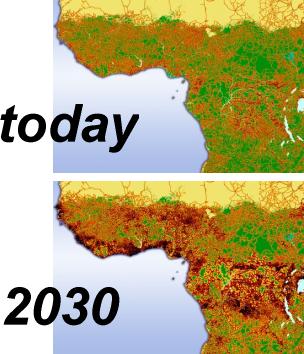The breaking of large, contiguous, forested areas into smaller pieces of the forest is forest fragmentation. These pieces are usually separated by roads, agriculture, utility corridors, subdivisions, or other human development. Fragmentation is a matter of concern primarily because of its impact on the conservation of biological diversity. It affects the size and quality of habitat for many wildlife species. Fragmented forests may consist of patches of forest too small to maintain viable populations of certain species. The smaller blocks of forest may not be of viable quality. When a forest becomes secluded, the movement of wildlife is inhibited. This restricts gene flow and results in long-term population decline.
Causes of forest fragmentation
The major causes of forest fragmentation are human settlement and infrastructure. A recent study shows that infrastructure increased the number of forest patches by 6%, and reduced the number of large forest patches by 71.5%. In Central India, patches were larger, but more isolated, while in the Western Ghats, there was a high number of smaller patches. This trend poses a risk to biodiversity, as small, isolated forest patches are likely to sustain fewer species and can increase the risk of extinction for resident wildlife.
Many animals of the Western Ghats, such as the endemic primates lion-tailed macaque and Nilgiri langur, are largely found in the tropical rainforest habitat. Besides occurring in continuous forests within protected areas, many species in the Western Ghats have significant populations in rainforest fragments outside protected areas. A study on the effects of forest fragmentation in the Anamalai Hills with animals like bats, spiders and diurnal large mammals showed that fragments play an important role as refuges for many species. Small fragments also have conservation value. This indicates the need to also target fragments for protection and ecological restoration in order to expand conservation into wider landscapes.

The Edge Effect
Fragmented habitats are usually of lower quality. This is called the ‘edge effect’. When a habitat is divided into smaller segments, the fraction of the edge where one habitat meets another, increases. Although few species can flourish along habitat edges, some struggle to survive. Examples of wildlife affected in this way include lichens, mosses and birds like treecreeper. Edge effects result in the alteration of growing conditions in the forest by extreme changes in light, temperature, moisture and wind. Microclimate near the forest edges are drastically altered. Environment of the adjonining non forest land influences the environment of the forest fragment (majorly on the edges). Fragmentation restricts mobility. Organisms struggle to move between habitat fragments, which can lead to decreased genetic diversity. This increases disease vulnerability and the risk of extinction. Fragmentation contributes to increased invasive plants (uncontrolled spread of non-native plants) in the habitat thereby increasing chances of spread of pests, pathogens and degradation of the water quality.
The dormouse (Muscardinus avellanarius) is an ideal example of a species affected by fragmentation. They spend most of their life among trees and can only travel small distances across open ground. Incapable to move across the fragmented sections of a habitat, dormice are restricted to isolated areas. Their populations are at risk from inbreeding and loss of genetic diversity. This has contributed to dormice numbers falling by more than 50% since 1995.
As the forest fragments become further small, utilizing the land for forestry becomes unsuitable, unserviceable and economically unfeasible. Due to this, the contribution of forestry to our culture and economy is lost. This phenomenon results in further fragmentation.
Effect on Predators
Predators have a very important role to play in the regulation of an ecosystem. Most predators are susceptible to the process of fragmentation and thus are found to be often missing from fragmented forests. When the top predators are lost, the food web falls out of place and the organisms residing at the lower end of the food chain can uncontrollably multiply. Herbivores like wild pigs, leaf cutter ants, howler monkeys and rodents have shown such effects. Trophic imbalances induced by fragmentation are now leading to fateful impacts on forests worldwide. This shows that the top predators are a radical part of a forest ecosystem. Forest fragmentation, through the predators have led to disastrous effects on the networking of the ecosystem.
Effect on Pollination
Trees in tropical forests, depend on animals for pollination. Pollination serves as a connecting medium between organisms in isolated forest fragment. Such long distance pollination can be carried out by larger species in the habitat such as bats and birds. Small insect pollinators are unable to contribute to pollination between plants with great distances. Fragmentation inevitably has wide negative impact on pollination and thus reproduction in wildlife. Animals from tropical domain help in dispersal of tree species. Research has shown that fragmentation lays a role in disrupting this process. Large-seeded trees are majorly impacted by fragmentation and this phenomenon usually results in the loss of almost all animals qualified of large seed dispersion.
Forest fragmentation has a significant ill effect on our biodiversity. This phenomenon needs to evaded to preserve our surrounding. We need to be well aware that humans and man made structures are one of the main carriers of forest fragmentation. Skillful measures need to be carried out to tackle this fast paced spread of forest fragmentation as it can lead to disastrous outcomes for wildlife and indirectly for humanity as we are fully dependent on the resources provided to us by the forests. Animals and plants are as much part of this planet as much as the so call developed human beings.
Written By- Krishang Sikaria
Help us Help Them! Think Wildlife Foundation is a non profit organization with various conservation initiatives. Our most prominent campaign is our Caring for Pari intiative. Pari is a rehabilitated elephant at the Wildlife SoS Hospital. 25% of the profits from our store are donated to the elephant hospital for Pari. Other than buying our wonderful merchandise, you could donate directly to our Caring For Pari fundraiser.
